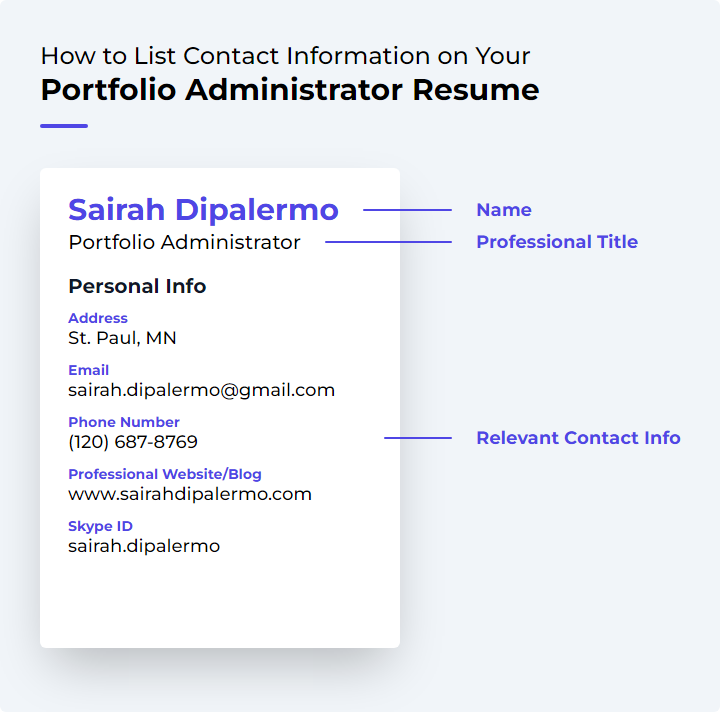Portfolio Administrator Resume Examples
Writing a great portfolio administrator resume is important because it is one of the first things a potential employer will see when they are considering you for a position. It is your opportunity to make a good first impression and sell yourself as the best candidate for the job.
Create your resume
Select from 7 professional resume templates
If you're looking for inspiration when it comes to drafting your own portfolio administrator resume, look no further than the samples below. These resumes will help you highlight your experience and qualifications in the most effective way possible, giving you the best chance of landing the portfolio administrator job you're after.
Essential Components for a Portfolio Administrator's Resume
A well-crafted portfolio administrator resume is a pivotal tool for showcasing your expertise in managing investment portfolios. It's essential to present a clear picture of your abilities, from reconciling account statements to generating financial reports and collaborating with investment advisors. A carefully tailored resume will underscore your competence in portfolio administration.
Let's delve into the key sections of a portfolio administrator resume, their importance, and how to optimize them to capture the attention of hiring managers.
1. Contact Information
Your contact information is the gateway for potential employers to reach out to you. Ensure it's current and error-free to avoid missing out on opportunities. Include your full name, phone number, and a professional email address. Depending on the job, you may also add your home address, LinkedIn profile, or personal website, ensuring they reflect a professional image.

Keep this section succinct and straightforward, avoiding unnecessary labels for clarity and ease of reading.
2. Professional Summary or Objective Statement
This brief yet impactful section should encapsulate your relevant skills, experience, and career goals. For a portfolio administrator, highlight your experience in portfolio management, analytical skills, financial market knowledge, and any pertinent qualifications.
An example summary might be: "Seasoned Portfolio Administrator with over ten years of experience in managing substantial investment portfolios. Adept at strategic investment planning and providing comprehensive administrative support. Holds a CFA certification and a Master’s degree in Finance."
Customize this statement to align with the job you're applying for and the value you can bring to the organization.
Related: Top Portfolio Administrator Resume Objective Examples
3. Portfolio Administration Experience
Detail your practical experience in portfolio administration, emphasizing responsibilities and achievements. Include specifics such as portfolio management, risk assessment, strategic planning, regulatory compliance, and financial reporting. Quantify your successes where possible, and mention any proficiency with portfolio management tools.
Highlight your ability to manage portfolios effectively within legal and policy frameworks, demonstrating your market knowledge and economic insight.
Employers seek candidates who not only have relevant experience but have also excelled in their roles, so be sure to articulate your accomplishments clearly.
4. Relevant Skills and Competencies
Showcase skills that are essential for a portfolio administrator, such as financial acumen, analytical skills, attention to detail, organizational skills, communication abilities, regulatory knowledge, computer proficiency, problem-solving capabilities, customer service orientation, and ethical standards.
Highlighting these skills will help employers recognize your suitability for the role.
Related: Portfolio Administrator Skills: Definition and Examples
5. Education and Certifications
Outline your educational background and any certifications that affirm your portfolio management expertise. Mention degrees in finance or related fields, and certifications like CFA, CFP, FRM, or CIMA. Also, include any ongoing education efforts and necessary licenses.
List your qualifications in reverse chronological order, providing institution names, degrees, and graduation dates. For certifications, include the certifying body and certification date.
Related: Portfolio Administrator Certifications
6. Achievements and Awards in Portfolio Administration
Use this section to differentiate yourself by listing measurable achievements and any awards received. Provide context for these accolades and quantify your success to illustrate your professional skills and strengths.
By highlighting your exceptional performance and recognition in the field, you demonstrate to potential employers your ability to not just fulfill but excel in your role.
7. References or Testimonials
References and testimonials serve as endorsements from those who can vouch for your professional achievements. Choose references wisely, ensuring they are willing and prepared to provide positive feedback. If references are not immediately requested, indicate their availability upon request.
Strong references or testimonials can bolster your resume by confirming the strengths and achievements you've listed.
By incorporating these elements into your portfolio administrator resume, you'll present a compelling narrative of your professional journey, increasing your chances of landing the role you desire.
